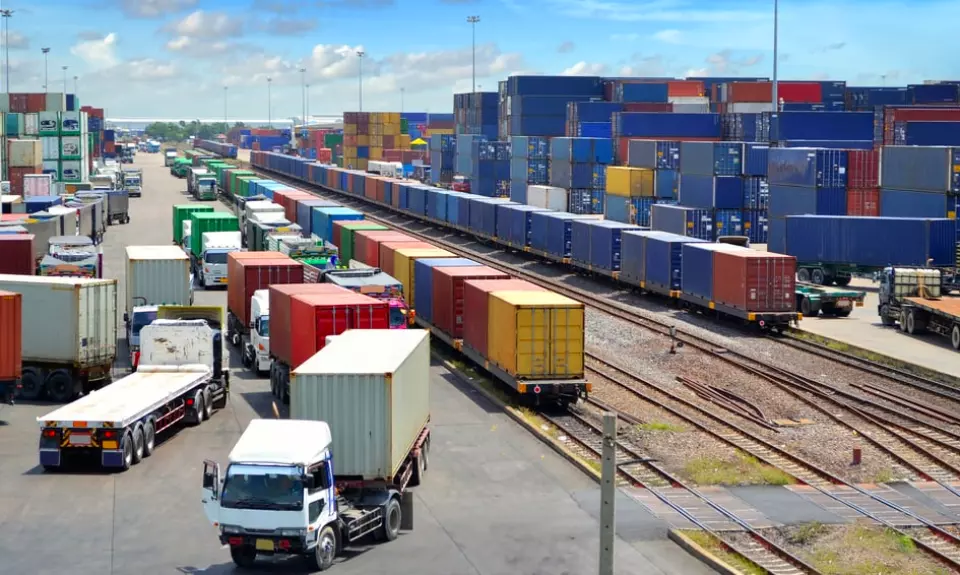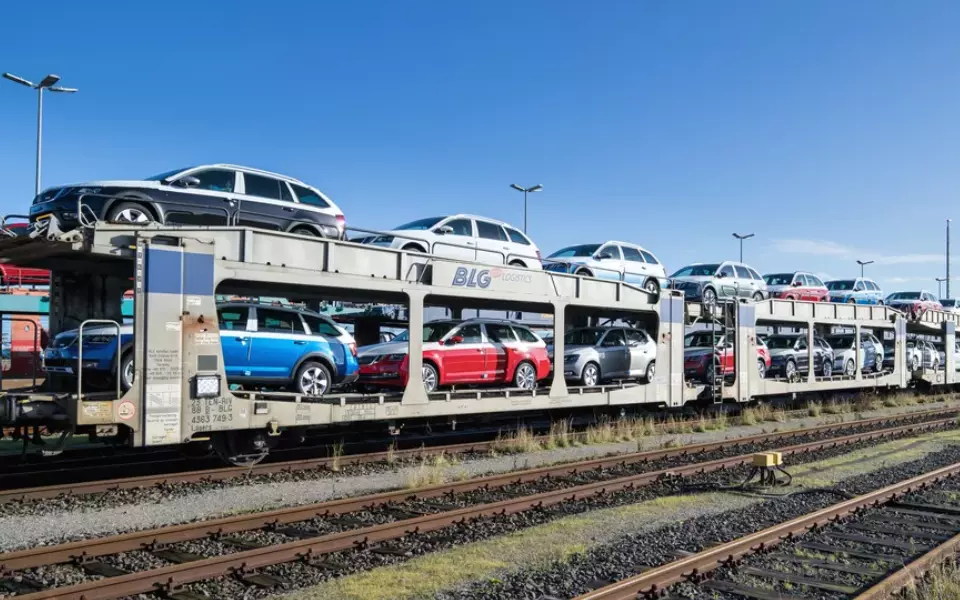The arrival of shipping containers in the late 1950s revolutionized the freight industry by enabling intermodalism. With this innovation, shippers could efficiently ship containers using different modes of transport in a single transit, including trucks, ships, and trains.
Intermodal rail is one of the most important parts of the global supply chain. It involves using freight trains and other modes of transport, such as a truck, to move cargo from an origin to a destination through an intermodal transport chain.
Today, many countries with an efficient rail infrastructure use intermodal rail to transport shipping containers from seaports across the country and across borders, before they are delivered to their final destination by truck.
In this article, we’ll dive deeper into the concept of intermodal rail, as well as its origins. We’ll also explain the infrastructure of intermodal rail and share the value that freight trains offer in the overall supply chain.
What Is Intermodal Rail?
Intermodal rail refers to the transportation of containers using freight trains. This is often done in conjunction with other modes of transport, such as road and sea.

The process involves transferring shipping containers at specified interchanges or locations known as intermodal terminals (such as seaports, rail terminals, and truck depots) into and off freight trains.
For example, consumer goods suppliers commonly transport cargo in shipping containers to rail terminals using trucks, which are then transferred onto freight trains, before they are transported across the country.
The core purpose of intermodal rail is to move cargo (often in intermodal containers) across vast distances more cost-effectively and reliably. Rail transportation is also a faster and eco-friendlier alternative to truck transport since trains can attach different railcars to a single engine and travel up to 50 mph with little or no traffic interruptions.
The Origins of Intermodal Trains
The history of intermodal trains goes back as far as the late 17th century. The concept began in England, where coal containers or loose boxes were deployed on railways from canals.
These boxes were then transported by road using horse-drawn vehicles. Moving coal in standardized containers allowed for a convenient way to transfer cargo from trains to other types of vehicles.
While trains were predominantly used for the transportation of coal during the early 19th century, they were increasingly utilized for the transportation of other goods, including raw materials, and finished products.
The Infrastructure of Intermodal Rail
Intermodal rail has a simple and streamlined infrastructure. This makes it one of the most reliable modes of transport for shippers looking to move cargo across vast distances.
In the sections below, we’ll expand on how intermodal freight trains work and outline the different types of facilities, equipment, and operations that are typically involved.
How Intermodal Rail Works
A typical intermodal rail transport process begins with cargo being loaded from trucks or other modes of transport onto well cars inside intermodal terminals. These terminals receive and store all types of shipping containers before they are loaded onto a freight train.
Intermodal rail freight facilitates various types of shipping containers such as tunnel containers, tank containers, dry containers (also known as general purpose containers), refrigerated ISO containers, and open-side containers, among many others.
These shipping containers are stacked onto well cars (typically double-stack cars) by trained operators using cranes or high-powered forklifts. The transportation activities are typically facilitated using documentation called a rail waybill, which is a contract of carriage between the freight owner and the carrier.
Intermodal Facilities
An intermodal facility is a dedicated transportation hub designed to facilitate the transfer of shipping containers between different modes of transport, such as trucks, ships, and freight trains.

These facilities are typically located at strategic points in a transportation network. Popular locations include major seaports, industrial highways, and border transfer points.
Moreover, they’re generally located in less congested areas and sites to ensure smooth and efficient transfers. Below is an overview of the most common types of intermodal facilities.
- Seaports – A seaport is a facility for ships to dock, load and unload cargo (typically shipping containers). Port facilities typically include container yards, loading areas, or docks equipped with port cranes.
- Airports – Most airports have a cargo terminal, which is a specialized facility located at or near an airport where cargo and freight are processed, sorted, and loaded onto or unloaded from aircraft. While cargo planes don’t move shipping containers, these cargo terminals often consolidate or deconsolidate cargo into or from shipping containers.
- Rail Terminals – Rail terminals are facilities used to handle and transship cargo from trucks or other modes of transport onto freight trains. These terminals are equipped with cranes and forklifts to facilitate the transfer process.
- Container Depots – These are facilities dedicated to storing containers temporarily for transshipment. They’re highly secure and provide multiple additional services, such as freight consolidation and container repairs/maintenance.
Intermodal Equipment & Operations
Intermodal rail transportation is widely acknowledged as an exceptionally versatile mode of freight transport, that offers businesses the ability to seamlessly transport various types of cargo including raw materials, pharmaceuticals, vehicles, and even livestock.
While most cargo is transported using intermodal shipping containers, carriers also offer different types of train cars (often called wagons) for various cargo types, such as flatcars, boxcars, gondolas, center beams, and more.
However, the most convenient and effective way to move general cargo is through the use of well cars that are designed to stack up to two intermodal shipping containers.
Advantages & Disadvantages of Moving Cargo Via Intermodal Rail
Moving cargo via intermodal rail offers various advantages and disadvantages to businesses worldwide, which we will explore in this section.
Advantages
In essence, intermodal trains are more cost-effective than trucks, especially for long-distance shipments. They can transport more cargo in a single trip than trucks, making them the most efficient mode of land transport.
A single railcar can transport up to 315,000 lbs in gross weight, which is nearly four times the maximum gross weight trucks can transport. The longest freight trains can reach lengths of more than 4.5 miles.
Intermodal trains also have predictable schedules, which allow shippers to plan their shipments more accurately. Moreover, depending on the quality of the rail network, intermodal trains experience far less congestion than highways.
Therefore, transit is smoother and generally faster. As mentioned above, freight trains have a much larger carrying capacity than trucks. As a result, they’re ideal for transporting bulk goods, such as cement, wheat, iron ore, coal, and similar types of cargo.
Furthermore, apart from facing less traffic congestion, freight trains can also reduce traffic congestion by limiting the number of trucks operating on roads, especially in urban areas.
Finally, intermodal trains are far more fuel-efficient than trucks, meaning they’re relatively less harmful to the environment in terms of greenhouse gas emissions. They have a smaller carbon footprint than trucks, planes, and ships.
Disadvantages
On the other hand, while intermodal trains can be used to transport various types of cargo, including perishable goods, it generally requires specialized handling or temperature-controlled transit.
In many cases, both options may not always be available in intermodal terminals. Secondly, intermodal train transportation requires access to an efficient rail infrastructure, which may not be available in all parts of a country, especially remote or rural areas.
As the use of intermodal rail transport often requires transshipment, the overall process and facilities required to enable this are typically more complex and time-consuming.
Moreover, the longer shipping containers are in transit, the more vulnerable they are to theft or damage, especially if they’re not properly monitored or secured.
What Type of Cargo Do Intermodal Freight Trains Move?
As mentioned in the previous sections, intermodal freight trains are among the most versatile modes of transport used by shippers, meaning they can be used to transport a wide range of materials and goods, including, but not limited to the following:

- Raw Materials – Freight trains are excellent for transporting various types of raw materials across vast distances, including wood, steel, plastics, coal, and more.
- Food & Beverages – Many shippers use intermodal rail transport to move food and beverages, including packaged and canned food items like beans, nuts & seeds, and oats, as well as beverages like wine, sodas, and more. Carriers with refrigerated containers also enable the transport of perishable items like meat, vegetables, and dairy products.
- Chemicals & Pharmaceuticals – Trains are a safer and faster alternative to trucks for transporting hazardous and non-hazardous chemicals, medical products, and pharmaceuticals on land.
- Vehicles & Equipment – Due to their high gross weight limit, freight trains are excellent for transporting multiple cars, trucks, cranes, and heavy machinery in a single trip.
- Consumer Goods – Freight trains can be used to transport several types of consumer goods in bulk quantities, including clothing, electronics, toys, cosmetics, and other manufactured products.
- Agricultural Products – Intermodal rail is one of the most important modes of transport in large-scale agricultural supply chains. Most shippers use trains to transport bulk quantities of grains, produce, fertilizers, cotton, rice, pulses, and more.
For more information on cargo and trail transport, make sure to check out our comprehensive article on what types of cargo freight trains transport.

Get Free Course Access
If you enjoyed the article, don’t miss out on our free supply chain courses that help you stay ahead in your industry.

Gerrit Poel
Co-Founder & Writer
at freightcourse
About the Author
Gerrit is a certified international supply chain management professional with 16 years of industry experience, having worked for one of the largest global freight forwarders.
As the co-founder of freightcourse, he’s committed to his passion for serving as a source of education and information on various supply chain topics.
Follow us